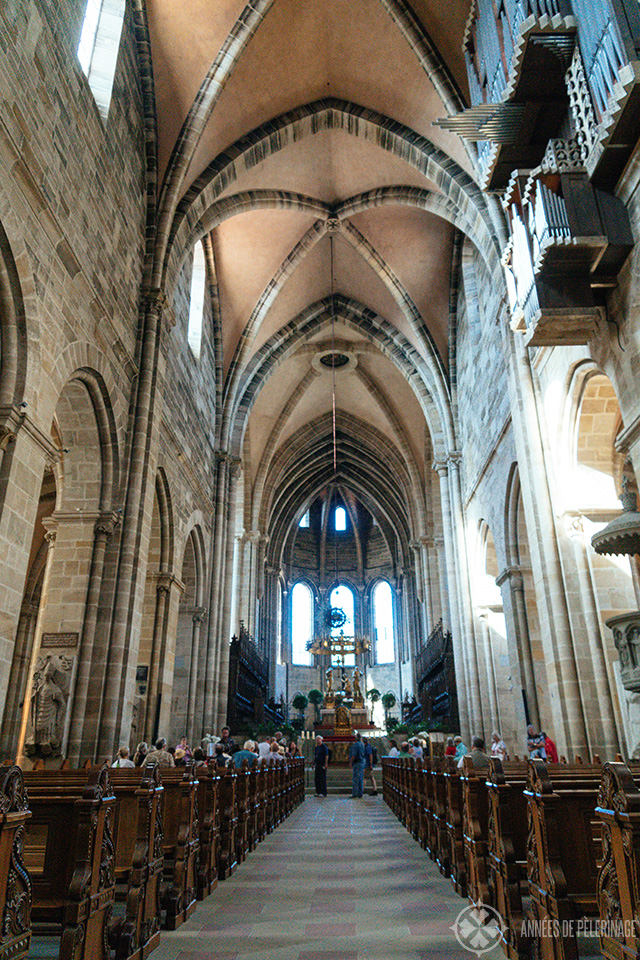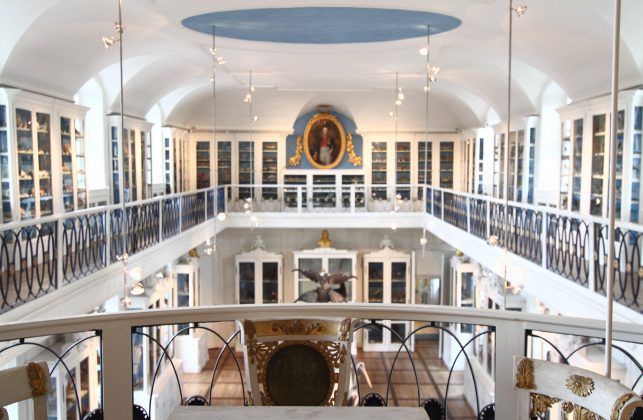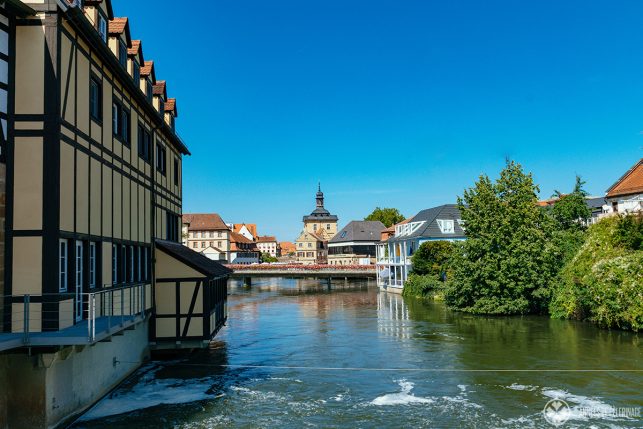A detailed travel guide with the top tourist attractions, landmarks and things to do in Bamberg. When to visit, what to see and where to stay.
Are you currently planning your Germany itinerary? And now you are wondering about the best things to do in Bamberg? Then this travel guide was written just for you.

The old town of Bamberg is an amazing UNESCO World Heritage site that will easily keep you occupied for a day. Like in a fairy tale, there are medieval half-timbered houses everywhere you look. Unlike so many others, the city in the heart of Franconia (like Nuremberg) wasn’t bombed out during WWII.
Since Bamberg is especially famous for its beer culture, you might even consider staying a night. As an alternative, it is also one of top day trips from Munich (roughly 2 hours)
An important tip before I start with my list of the top things to do in Bamberg! If you plan to do some serious exploring, definitely consider booking the 3-Day BambergCard for some serious savings on museum entrance fees.
Note: I earn a small commission for purchases made through links in this article.
1. Old Town Hall

The most famous tourist attraction in Bamberg is, quite without a doubt, the picturesque Old Town Hall (Alte Rathaus). It dates back to the middle of the 15th century and was built on an artificial island. You see, back then, the ruling bishops didn’t want to grant the emergent bourgeoisie any land to build their townhall. But nifty as they were, they hammered stilts into the riverbed and erected the imposing gothic building to defy the prince-bishops.

Note: For the best view, go to the adjacent Geyerwörthsteg bridge. The light will be better in the morning, in case you plan to take any pictures.
All in all, the Old Town Hall is the perfect spot to start your Bamberg walking tour. The old town is really beyond beautiful. Consider going on a guided tour (this one currently is the most popular) as it will be so much more meaningful with a knowledgable guide who can supply background information.
2. Bamberg Cathedral

Much like Rome, Bamberg was built on 7 hills. This will become quite apparent once you climbed the cathedral hill. From up here, you’ll have a magnificent view of the old town. Of course, you’ll also be able to check out the magnificent Bamberg Cathedral.

The current building dates back to the 12th century, though the foundations are even older yet, as Bamberg Cathedral originally was consecrated in 1012 AD. It’s truly that ancient, and certainly one of the reasons the UNESCO declared it a World Heritage site.
The interiors are quite austere. King Ludwig I. of Bavaria ordered all baroque style additions to be removed in 1830. He wanted the original and “pure” romanesque interiors to be restored. Which is ironic, as the cathedral was originally painted quite colorful as most recent research indicated.
3. New Residence Bamberg

Throughout the late medieval times and the Baroque, Bamberg was a powerful city. The New Residence (Neue Residenz) is a testament to the power of the Bishops and Electors of Bamberg. You should definitely consider a tour of the imposing building right next to the cathedral.
In the past two decades, a dedicated team of labored to restore the New Residence to its former glory. As their work is almost finished, nothing speaks against going inside.

There is also quite the wonderful art gallery (German medieval and Baroque style art) inside, which you will get to see as part of your tour.
Note: You can only visit with a guide. Tours start roughly every 15 minutes.
4. Klein Venedig

One place you absolutely have to check out is called Klein Venedig (“little Venice”). The picturesque row of half-timbered houses along the left arm of the River Regnitz really screams to be photographed. It’s not even hard to reach, as you already can see the first houses from the old town hall.

Still, you should take your time and walk a little further south along the banks of the river. It’s worth it, though I am not sure about the connection with the famous city in upper Italy.
5. Seehof Palace near Memmelsdorf

As pretty as Bamberg’s historic old town may be, it really pays off to explore the vicinity as well. Bus #907 will get you to the village of Memmelsdorf where the beautiful Seehof Palace is located. This is the former summer palace the prince-bishops and a true must-see in Bamberg.

There is a huge orangery on the grounds and a giant water cascade. The gardens are also quite worth seeing. Best go here in the afternoon and enjoy tea time at the restaurant.
Note: Buses leave from the ZOB (Central Bus Terminal) almost every 10 minutes
6. Old Court & Historische Museum

I already mentioned Bamberg’s ancient city. The Old Court of Bamberg (“Alte Hofhaltung”) is where it all began. As early as 600 AD, an ancient castle is documented for the place. The old court is the place where the prince-bishops resided – before the construction of the New Residence.

What you see today, is alas only a little part of the former old Court buildings. A huge portion of the ancient buildings was torn down in 1777. Still, what remains is quite impressive. You can even go inside. The Old Court of Bamberg is now home to the historic museum.
7. The Rose Garden

One of the best things to see in Bamberg in summer is the fabulous rose garden in one of the courtyards of the New Residence. It’s one of my personal favorite points of interest in the city. Just imagine the fragrant smell of probably a hundred different kinds of roses. Add in a lovely little fountain, many baroque statues and you get the full picture.

You’ll also be able to enjoy a lovely view of the old town, so the visit will be worth it even in winter. Plus, it’s one of the free things to do in Bamberg anyway.
8. Sammlung Ludwig in Bamberg

In Bamberg, you get the chance to view one of the finest collections of early European porcelain in the world. You’ll find the Collection Ludwig inside the Old Townhall.

There’s another reason to visit this museum: On the second floor, you can explore the former courtroom of the old town hall. Here’s the website. I am not even sure why so many tourists are afraid to go inside. Beautiful as the Town Hall is, just taking a picture from the outside seems a bit superficial, eh?
9. Lock no. 100

Europeans have dreamt of connecting the River Main with the Danube since the beginning of time. Even Charlemagne started the construction of the canal to connect them both in the 8th century. In theory, this canal would connect Rotterdam with the black sea and form a powerful trade route. The project was finally finished in 1846.
100 hundred locks were needed to make up for 264 meters of difference in height. The last of these locks was built only a couple of meters away from the city center of Bamberg.
The Main-Danube-canal ended up being an economic disaster. It was too small, not deep enough and the burgeoning railway industry quickly made sure the canal was not competitive in the long run. Still, it does mark an important point in European history.
10. St. Michael’s Abbey

On the hill next to the Bamberg Cathedral you cannot help but notice an ancient Abbey. The buildings are part of the UNESCO World Heritage site. The church of the former Benedictine Abbey famous for the late renaissance ceiling frescoes often referred to as the “herbal garden”.
The ancient organ prospect also dates back to the early 17th century, even though most of the rest was re-decorated in the Baroque style about a hundred years later.

Note: The Abbey is currently being renovated (until 2025!). You, sadly, cannot go within. The terrace below offers a very lovely view though, and there are two nice restaurants perfect.
11. Böttingerhaus

The Böttingerhaus (house of Böttinger) is another place that appears in a lot of Bamberg travel guides but is once again off-limits. The wonderful private Baroque-style mansion from 1713 is now privately owned. It’s still an important landmark, you might want to check out on your stroll through Bamberg’s old town – if only to gawk at it from outside.
12. Altenburg Castle

Ever wanted to see a medieval castle in person? Then you should head out to Altenburg castle. You’ll find it high upon the hills of Bamberg, roughly 2 kilometers behind the Cathedral (takes about 20 minutes on foot to get there). From here, you get to enjoy a lovely view of the surrounding areas. There’s also a restaurant inside – so maybe the perfect spot to enjoy lunch.
13. Naturkunde-Museum

If you are visiting Bamberg with kids, you might want to check out the natural history museum. Even without, this is quite a lovely place to spend a rainy afternoon. The museum opened in 1791 and will impress you with a spectacular exhibition room from that time: The Hall of Birds (Vogelsaal). Here is a link to the official website.
14. Diocese Museum

If you got some spare time in Bamberg, the Diözesanmuseum (Diocese Museum) right next to Bamberg Cathedral could be just the perfect spot for you. This museum houses the treasury of the cathedral with quite some spectacular exhibits. Like the extremely well preserved papal regalia of Clemens II. form the 11th century! Here is the website.
Note: If you plan to see the New Residence, this museum and a guided tour of the Cathedral, there is a cheaper combination ticket
15. Obere Pfarre / Church of our Lady

Bamberg has plenty of churches you could visit, but I definitely urge you to check out the Church of our Lady (called “Obere Pfarre”). Why? Well, the imposing building from the 14th century has quite some lovely art inside – most notable perhaps a huge painting by Jacopo Tintoretto.

The high altar from the 17th century is also worth noting. Unlike the Bamberg Cathedral, this church was not “purified”, so you’ll get to experience a more colorful interior! I especially loved the beautiful organ prospect
[Bonus] Staatsbibliothek Bamberg
Did you know know that Bamberg was honored by the UNESCO twice? Yes, not only the old town is a World Heritage site. Deep inside Bamberg’s library hide three ancient codices that are part of the UNESCO World Document heritage
For example the Lorscher Arzneibuch (click here to view the original) from 785, which is one the oldest (surviving) book on western medicine in the world. Entrance to the library is for free and they usually have a lovely exhibition on the ground floor.
Note: You cannot view the most ancient texts inside. They have all been digitalized. Roughly once a month, you can tour the historic rooms on the second floor, tho.
Other things to do in Bamberg

All things considered, Bamberg isn’t all that big. So, my list of the best things to do in Bamberg is quite complete. I did not mention each and every single small museum or church. E.g. the Bamberg Nativity Scene Museum, the Museum Kutz or the Bumiller Collection.
If there is one further thing you really should do in Bamberg, then it’s sampling the local beer. Bamberg is famous for it and there are probably a hundred small little breweries in town. Which is why I can really recommend going on a guided beer tour (this one has the best reviews!)

At the end of the day, just walking through the old town or the Garden City will be spectacular. After all, the UNESCO didn’t just inscribe just a couple of buildings into the World Heritage List, but the whole city as it is just so well preserved and still living and breathing just the way it has been for centuries.
Luisenhain park
Are you more the outdoor person? Bamberg has a very lovely landscape garden right on the banks of the River Regnitz you could go for a walk. Luisenhain park is quite large and starts right behind Lock No.100 I mentioned before. So, you could combine these two!
The park really is pretty, and there is even a small botanical garden within!
Where to stay in Bamberg
I already said it once, and I’ll say it again: Staying a night in Bamberg is actually a good idea as it really gives you the opportunity to experience a night at one of the many small breweries. Obviously, you can easily visit it on a day trip from Munich (make sure to read my guide to the top 50 things to do in Munich), but as Bamberg is cheaper Bavaria’s capital, it might be a smart move to resettle.
Here is my choice of hotels for you:
The best luxury hotels in Bamberg:

Hotel Residenzschloss (book it here) is probably the most opulent place to stay in Bamberg. Here, you get the chance to sleep in a former aristocratic palace, so how cool is that? The hotel is a bit further outside (well like 300 meters), so a bit quieter in the evening.

Another lovely place is Hotel Nepomuk (book it here). It’s located inside a historic building right on the River Regnitz with spectacular views from (most of) the rooms! If you want to be right in the middle of things, this is YOUR place.
The best budget hotels in Bamberg
If your travel budget is a bit tighter, you will thoroughly enjoy the Hotel Am Dom (book it here). It’s extremely central and will give you an excellent bang for your buck.
Another good alternative is the ibis Bamberg Altstadt (book it here). It’s quite a small hotel with an excellent location right in the heart of the old town offering a reliable international standard.
Best time to Visit Bamberg

Bamberg is incredibly popular, especially among international tourists. Especially on weekends in Summer, it can get quite full in the narrow alleys of the old town. Still, the German weather can be quite fickle. So, June, July, and August really are the best time to visit Bamberg.

At the end of August (around the 24th) the most important city festival will take place. During Sankerwa (local dialect for “Anual consecration festival for the St. Elisabeth church”) the whole old town transforms into one big street food and beer festival. It usually lasts from Thursday to Monday and is one of the biggest events in Bavaria!
Other than that, Bamberg is pretty much worth a visit throughout the year. Winter will be very quiet, except for December, where (especially local) tourists love to visit the Christmas market.
Last, but certainly not least, here are some other amazing UNESCO World Heritage sites in Bavaria you might want to check out:
- Blaubeuren – the world-renowned Prehistoric highlight
- Augsburg’s medieval water management system
- Wieskirche – A Rococo dream come true
So, this was my little travel guide to the best things to do in Bamberg, Germany. Hope I was able to give you a good overview. Still got some questions? Ask them in the comments below.








